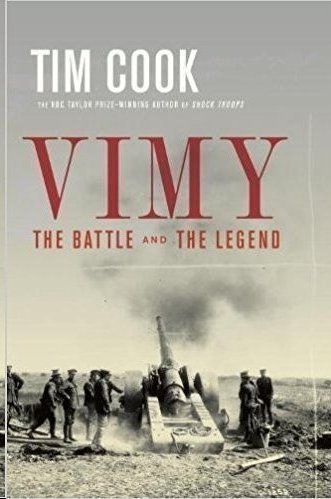"VIMY - The Battle and the Legend" by Tim Cook

Above: "VIMY - The Battle and the Legend." Tim Cook - 384 Pages
This is an esoteric book about a WWI victory against German forces by a consolidated Canadian force ensconced within the British Expeditionary Force (BEF) and how that victory has been massaged over the last one hundred years to serve as a symbol for Canadian national unity.
I completed reading this book today.

Above: Mwah (sic) at Vimy Ridge, Vimy Monument in the background. Pas de Calais, France. 29 September 2015.
Background:
This is an esoteric book with a focused subject about a WWI victory by a consolidated Canadian force ensconced within the British Expeditionary Force (BEF), and how that victory has been massaged over the last one hundred years to serve as a symbol for Canadian national unity.
Vimy memorial, in the background of the image behind Mwah (sic), designed by Canadian sculptor, Walter Allward, was completed in 1936. The monument was restored for the Vimy battle's fiftieth anniversary celebration, in 1967. The monument has become a symbol of Canada's nationhood as distinct from her prewar position as loyal member, though titularly independent from 1867, of the British Empire.
Browsing a bookstore in Smithers, BC, in June 2017, and seeking something to read relevant to the Canadian experience, I came upon the recently published book, published to coincide with the centennial anniversary of the Battle of Vimy Ridge.
I had visited Vimy Ridge as part of a WWI battlefield tour in the fall of 2015 (see image). So, serendipity took hold at the bookstore and I purchased the book. I hoped to read it and use it as a means of better understanding Canada, a country where I had traveled quite a bit, but, also a country about which I didn't know very much... not that I hadn't formed some prejudices about Canada over the years. For example, Canadians traveling around the world with big maple leaf Canadian flags pasted all over their luggage, seemingly to advertise, "hey, we're not Americans," has long been an irritant. There's room for another essay here.... I might get to it.
Context:
Vimy was a WWI battle, where for four days beginning on Easter Sunday, 09 April 1917, four Canadian divisions fought a victorious battle against the Germans on Vimy Ridge, a strategic elevated German stronghold on the Western Front, not far from Arras.
In the grand scheme of things, the Vimy battle was a part of the larger Battle of Arras, which was, in turn, part of the Allies' Nivelle Offensive, undertaken in early April, 1917. The British Expeditionary Force (BEF) had agreed to engage the Germans at Arras (including Vimy) to draw German attention away from Aines, fifty miles south along the Western Front, where the French would undertake a major offensive to try to breach the German Hindenburg Line.
Post the punishing, stalemated, iconic, Western Front battles of the previous year (1916), Somme and Verdun, the Germans decided to dig in for 1917... to hunker down... and hope for a break on the Eastern Front as the Russians crumbled into revolution, and to allow for war weary public opinion to force Allied leaders to sue for a negotiated peace.
The Allies, on the other hand, notwithstanding 1916 setbacks, decided they needed to make a 1917 attempt to break through the German lines... hence, the Nivelle Offensive.
But for the success at Vimy, the Allies had their worst year of the war in 1917. The 1917 Nivelle offensive was fought to a stalemate. While the Canadians pushed the Germans off the ridge at Vimy, they were unsuccessful breaching the German line. Later in the year, the Allies' attempt to break through German lines at Ypres, failed - Third Ypres, or the Battle of Passchendaele. By the end of 1917, the Russians gave up fighting WWI as their country fell into revolution and internal fighting. Twelve battles ending in stalemate fought by Italian forces against the Austrians on the Isonzo River, in the eastern sector, Slovenia, ended with the collapse of Italian forces at Caporetto.
By the end of the 1917, the United States had decided to enter the war on the side of the Allies, but the doughboys would not be in a fighting position until well into 1918. Meanwhile, as Russia collapsed on the eastern front at the end of 1917, Germany was able to deploy several Division from the east to the Western Front, to attempt an offensive in early 1918 when the allies were at their worst and before the Americans could be effective.
In four days of fighting at Vimy Ridge, there were ten thousand Canadian casualties, including four thousand killed.
The Book:
Cook divides the book into two parts.
The battle itself: buildup and the fight, takes up about a third of the book. We learn about how the Canadian commanders mastered the military art of the rolling artillery barrage, where artillery barrages in previous WWI engagements had resulted in many friendly fire casualties. We learn how well trained the Canadian troops were and how changes in the field command structure allowed for lower level troops to pursue the battle even when their officers were down. And, we read first hand accounts written, usually from archived soldiers' letters to home, about the horrors of the actual fighting.
Two thirds of the book deal with the aftermath of Vimy over the one hundred years since the battle was fought. The book explains how Vimy, notwithstanding that it was a minor battle within the broader context of WWI, became a symbol - not without opposition - of Canadian nationhood. Long after the war, General Currie, Canada's top ranking officer at Vimy, declared that the Canadians fought more difficult battles than Vimy where they also distinguished themselves... Passchendaele (Third Ypres) in late 1917, for example. Why single out Vimy as a national symbol? Currie queried.
We learn the story of sculptor Walter Allward's monument. It took a long time to construct... it wasn't completed until 1936 and Canadians, suffering through a depression, wearied of the tedious, delay in building it. By the time of the monument's completion, sadly, Allward was not a popular figure in Canada. Today, Allward's monument is seen to be one of the great monuments of the Great War, up there with Menin Gate at Ypres, or the Thiepval Monument at Somme.
There is a detailed account by Cook of the Allward monument's dedication in 1936, including the national financial sacrifice, in difficult economic times, of getting some 7000 war veterans to northern France for the monument's dedication.
French president Charles DeGaulle stirred the diplomatic pot at the battle's fiftieth anniversary celebration in 1967 by trying to prevent Britain's Queen Elizabeth from joining the ceremony. " It should be a Canada-France celebration," said De Gaulle, In the end, the Queen stayed home and Prince Phillip joined. The Canadians weren't happy with DeGaulle after that.
During the next year, DeGaulle visited Canada and gave a speech at Ottowa, declaring "vive Quebec Libre!" further exacerbating the already tense relations between France and Canada arising from the Vimy celebration the year before.
In addition to General Currie, there has been other resistance to Vimy's certification as a symbol of Canadian nationhood. The Quebecois were more or less uncooperative in supporting WWI. That attitude carried over to their lack of support for celebrating Vimy as an event of national significance. Also, Canada's labor unions, who became anti-war as Canadian deployment to the BEF ramped up, remained, post war, outside the Vimy symbol camp.
The need for a war symbol of Canadian unity arose out of realization that Canada never had a war of independence. Up until Vimy, the crucible of blood sacrifice on behalf of the nation had been empty.
Cook takes us through the historical ins and outs of Vimy's role in the Canadian zeitgeist and leaves the reader with the impression that in modern times, there is strong government support for mythologizing Vimy as a symbol of national sacrifice.
Twenty five thousand Canadians attended the centennial celebration of the Battle of Vimy Ridge in April of this year. It seems that a sense of Canadian nationalism is rising surrounding the battle, notwithstanding Canada's having sought an identity as a peacekeeper for the United Nations, during the prime minister-ship of Lester Pearson in the 1950's. Pearson won the Nobel Peace Prize for his efforts in 1957.
This is an esoteric book about a WWI victory against German forces by a consolidated Canadian force ensconced within the British Expeditionary Force (BEF) and how that victory has been massaged over the last one hundred years to serve as a symbol for Canadian national unity.
I enjoyed reading the book. Beyond the Canada story, the book filled in some gaps in my understanding about the broader war along the Western Front in 1917.
I visited Gallipoli in early 2015. Despite Gallipoli being a failed effort for the Allies, the nearly year long battle, like Vimy did for Canada, became a touchstone of Australian nationalism.
Vimy and Gallipoli are both important subjects for anyone interested in the process of the winding down of the British Empire.